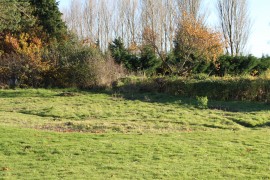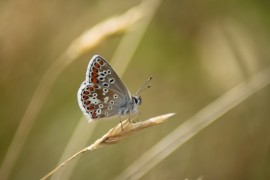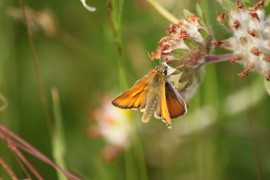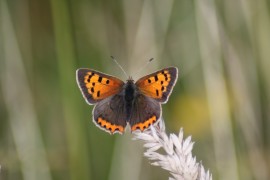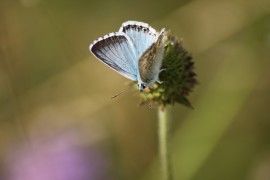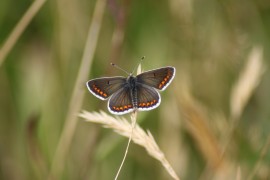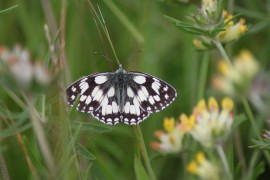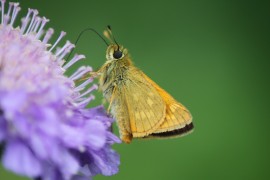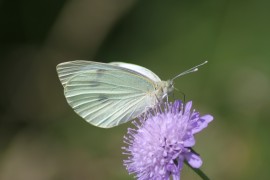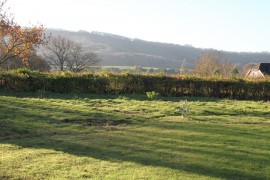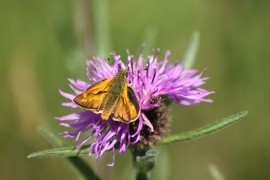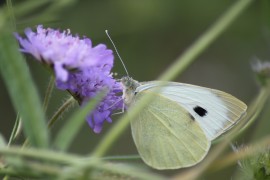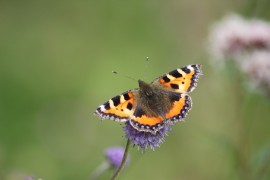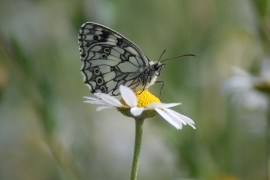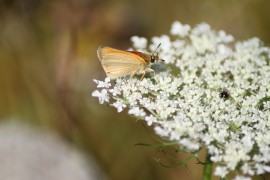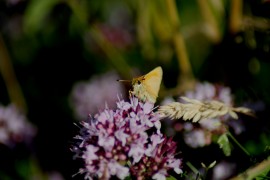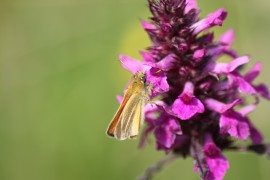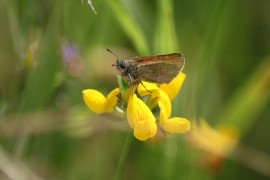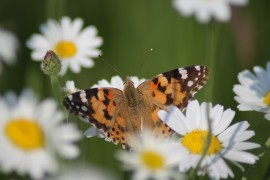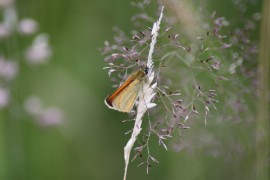Wildlife gardening - the Wildflower Meadow
By Martin Kalaher
In this second article on wildlife gardening I am going to focus on the wildflower meadow. Over the past 10 years I have recorded 32 butterfly species in the back garden, of which 29 were seen in the wildflower meadow. It is an amazing habitat, providing an abundance of nectar and larval food plants for a variety of butterflies, bees and a myriad of other insects. It also provides me with endless hours of pleasure and contentment, but before I get too carried away I should mention that it also gives me many hours of manual labour! The meadow is a work-in-progress and is probably several years away before my workload is reduced to a single autumn cut.
In 2016 I now have what I would call a wildlife garden but it has been a slow evolution over the 23 years we have lived here. In 1995 we planted a mixed deciduous hedge on two borders of the garden and in 2004 we dug a garden pond. In no time at all there were dragonflies, damselflies and other assorted pond life but what about butterflies and bees. Where were they? Not in my garden, that's for sure. All those lovely butterflies on nearby downland but they didn't come my way. I knew what I had to do but it was going to be a very large undertaking and would drastically change the character of the garden. This was one of those ideas that pinged about in my head. Do I, don't I? Do I, don't I? Finally, I made my mind up, consulted 'the boss' and got permission, sharpened my trusted spade and began digging in late-winter 2005.
All the turf with its topsoil was removed and transported to the western side of the garden, creating banks for voles, slow worms, grass snakes and many other creatures. Having exposed the subsoil, that was dug that up too and what was left of any topsoil, all mixed in. The end-result was very infertile soil, more-or-less free of any roots. Having prepared the soil, a seed mixture of grasses, perennial wildflowers and annuals was sprinkled on. It took three winters to complete the digging, creating a meadow of around 17metres by 14 metres. This has proved to be a nice size, big enough to support a wide variety of breeding butterflies but not totally dominating the half-acre back garden, leaving plenty of room for the grandchildren to play.
Within 3-4 years the meadow was looking good. The very poor soil quality meant that I never had any problems with nettles, thistles or docks. The grass species were establishing nicely and the ground cover was very attractive (to my eyes) with Birdsfoot Trefoil the dominant species. The flowering plants that came to the fore were Greater Knapweed, Ox-eye Daisy and Wild Carrot. I'm not too sure one can ever have enough Greater Knapweed but the other two were doing rather too well. If I had been content to let these three take over I would have a wildflower meadow but would there be the variety I was looking for? Some weeding was required back then and in 2016 it still is.
By 2013 I had another problem as there were too many vigorous grass species. The problem was mostly with Yorkshire Fog but others too were making inroads. Now since Yorkshire Fog is the preferred grass species for Small Skippers and I love my small colony of Small Skippers, I didn't become too agitated. But, did I want a grass meadow or a diverse flower meadow? A simple question with a simple answer - I wanted more flowers. OK, if more flowers, which ones? I decided on Marjoram and Betony. With regards to Marjoram, I had one of those 'eye-opening' moments about four years ago, when I was doing a butterfly survey in high summer. As I descended the middle combe at Chantry Hill I could not quite believe what was in front of me. Hundreds of square metres were covered in a carpet of flowering Marjoram with 1000s of nectaring honey bees and bumble bees. Bathed in warm sunshine it was quite spell-binding and I can honestly say I have never seen so many bumble bees in my entire life. It was an astonishing sight. From that moment on I was totally sold on Marjoram as a meadow wildflower. Betony was just 'a bit of a punt'. I like the bold, rather 'orchid like' flower heads and I was keen on having more of them in the meadow. At that time, I wasn't aware of any wild Betony in my local area but I was familiar with the species elsewhere in Sussex. I had a few already in my flower meadow, which had germinated from the original seed mix. Although they were surviving, year-on-year, they weren't doing that well. It was time to adopt a different strategy.
In the autumn of 2013 I bought Marjoram and Betony plugs and potted them up, putting them in an unheated room above the garage. The winter was mild and by the spring the potted plants had put on some growth and more importantly had reasonable root balls. During the winter months, I prepared some beds within the wildflower meadow and the herbaceous border, using the latter as a nursery bed. As mentioned in my article on the herbaceous border I am very prepared to use plenty of compost to promote the growth of the root ball. In September 2014 I transferred all the Betony and most of the Marjoram to the meadow.
I could not have wished for a better outcome. Over the past two summers the wildflower meadow looks much better with an improved flower/grass ratio but more importantly the number of butterflies/bumble bees and other insects have increased considerably. In late July, it is not unusual to have 30-50 butterflies just in the meadow itself, with close to 100 butterflies in the entire garden. The 25 second-brood Common Blues recorded in the meadow in 2015 was especially pleasing. The meadow now contains approximately 60 British native flowers and 12-15 species of grass. Some are there courtesy of the original seed mix, some I have planted and some have arrived naturally, presumably wind-blown seeds. I have 20 small beds within the meadow and I am prepared to weed these beds until the Marjoram and Betony are fully established. I suspect I will be tinkering with the meadow for a few more years and then hopefully I will be able to leave it alone with just a single cut in late August/early September.
I fully accept that the meadow has evolved in a very strange way and if I were to start again I would do things differently. After preparing the bed of soil I would put in scattered groups of potted plants, and then sprinkle on the commercial seed mix. The cost can be kept down by ordering plugs and potting them on. If funds will allow then buying in pots saves time and labour. In September 2014, I bought some pots of Marjoram and Betony from my usual supplier. The quality was superb and at ?3 per pot I couldn't argue with the price. As mentioned in my article on the herbaceous border I planted some of the Betony in a nursey area, bedding in the plants using well-rotted garden compost. When I transferred them to prepared beds in the meadow one year later the Betony typically had root balls 9-10 inches across and 7-8 inches deep. I am confident these plants will always do well. This is all very contrived and artificial but what do I care if the end-result not only looks good but more importantly delivers what I want, a garden full of interesting insects. A life-long ambition fulfilled!
I will mention Yellow Rattle as I appreciate that some meadow enthusiasts are great fans of this parasitic plant. I believe it is excellent for encouraging orchids although as it happens I have some of those, anyway. One small area of the garden meadow where Kidney Vetch thrives had seven small Common Spotted Orchids in 2016. I didn't plant them, they just appeared. I have scattered some Yellow Rattle seed in this part of the meadow, which if they germinate should help this area to become an orchid bed. We shall see. As with all gardening some things work out well and some things don't. The key is not to get despondent with the 'failures' but be happy with the success stories!
The back garden is now full of butterflies, bumble bees, hoverflies and other assorted insects. Other parts of the garden have played their part (especially the recently-enhanced herbaceous border) but there are no doubts as to the huge benefits of having a wildflower meadow. I have good reason to believe that 12-13 butterfly species have either bred or attempted breeding in the meadow, the species list with daily maxima as follows: Gatekeeper (40), Meadow Brown (25), Common Blue (25), Small Skipper (12), Large Skipper (10), Marbled White (6), Essex Skipper (5), Ringlet (3), Brown Argus (3), Small Copper (2), Small Heath (2) and Green Hairstreak (1). The 13th species relates to a single female Small Blue, which visited the garden very briefly, some years ago. As it was perched on Kidney Vetch (when I inadvertently disturbed it) it may well have laid an egg or two. In 2016, I was especially pleased when Essex Skipper bred for the first time, which meant that there were small breeding colonies for all three meadow Skippers.
So, what British natives would I recommend for the wildflower meadow? I am happy enough to go along with the mixes provided by the commercial companies that specialise in British flowers. Don't expect all to germinate and don't expect them all to survive because they won't. Or some might survive for a few years and then disappear, either because the conditions are too dry or they are 'choked' out by other plant species that do better (and this is where some grass species can be a problem, if your aim is to have lots of flowers). The list that follows is highly suitable for sandy soil.
Greater Knapweed
A staple plant for any meadow, it has a lovely, intricate flower head. The clumps gradually enlarge over the years and can be split in the autumn if more plants are required.
Field Scabious
Another lovely meadow plant, which looks good either scattered throughout the meadow or in small clumps. Both butterflies and bees find it irresistible. Will readily self-seed on any available bare soil.
Devilsbit Scabious
As the flower heads are quite small I think it looks much better with half a dozen or more planted close together. The British native variety flowers in late July though most of August and provides nectar when most other meadow flowers have gone to seed. This plant species is a huge favourite with bumble bees but for some reason butterflies do not seem quite so keen.
Ox-eye Daisy
Watching a few dozen big daisy heads wafting in the breeze is one of the joys of the English summer. Butterflies do visit the flower heads to nectar but if other alternatives are available in the garden, it can be largely ignored. It self-seeds prolifically and therefore can provide your meadow with lots of flowers but to the detriment of variety. Needs to be kept in check.
Wild Carrot
This Umbellifer has an attractive flower head and is much loved by hoverflies and beetles. Butterflies largely ignore it. This is another plant that self-seeds prolifically and will quickly colonise any bare soil. Needs to be kept in check. Other elegant tall plants that look good in the meadow and do well in sandy soil are Musk Mallow, Meadow Cranesbill, Meadow Buttercup and Dropwort. None of these four are especially favoured by butterflies but they are lovely additions to any meadow. Dropwort is usually associated with chalk downland but it grows well-enough in sandy soil. I think it is one of those plant species that looks good in a clump, so one might consider planting several plants close together.
Marjoram
A 'must' for any wildflower meadow. The stem height does vary but it will generally fare better where the sward height is low, otherwise there is the potential for it to be swamped by taller species. Perhaps best planted on the edge of the meadow where it can be tended.
Betony
Not far behind Marjoram as a superb meadow flower with interesting basal leaves and a lovely, orchid-like flower head. Bumble bees and butterflies find it irresistible. Looks good in clumps of 6-12 plants.
Ground Cover
When establishing a new wildflower meadow there is no need to fret too much about the ground cover as the commercial seed mixes will contain all that is required, and the rest is likely to come through natural colonisation. No bare soil stays bare for very long! The one essential flowering British native is Birdsfoot Trefoil. It has a delightful deep yellow/orange flower head, which transforms the meadow in May and June and provides nectar for so many of our native insects. I am very fond of Red Clover, which looks lovely in the meadow and both Lady's Bedstraw and Salad Burnet provide 'authenticity' to areas of meadow where the sward is shorter. Otherwise, both Common Vetch and Tufted Vetch are very welcome and I would include Kidney Vetch as it has a fine yellow flower head and you never know a Small Blue might come along to investigate!
Biennials and annuals
In the early years of a wildflower meadow both annuals and biennials flourish as there is plenty of bare soil available for the seeds to germinate. Once the grass and ground cover species become well-established and the soil is no longer disturbed, the biennials and annuals gradually disappear. As I have 20 small beds within the meadow to accommodate both Marjoram and Betony there is plenty of disturbed bare soil to keep other plants going, for another 2-3 years at least. After that we shall see. My wife, Mary, likes annuals. So, there is a good chance that I will find a way to keep them going! A meadow purist may raise an eyebrow but my view is that since the whole exercise is completely artificial, one might as well have the plants that are enjoyed. Viper's Bugloss is a superb biennial much loved by bumble bees and Corn Cockle, Cornflower, Corn Marigold, Poppy, Scentless Mayweed all look good and attract a pleasing variety of insects.
Grass species
I have never troubled myself trying to identify all the grass species in my garden. That's an omission which I will try to rectify next year. Fortunately, when establishing a new meadow, it is easy to obtain a commercial seed mix, containing a varied selection of grass seeds suitable for different soils. The original fine grass species in my meadow have been added to over the years, recruiting some of the more vigorous species that are common enough in our immediate vicinity.
Maintenance
The simplest maintenance is to let everything grow naturally and to take a single cut in late August or September. All the 'meadow hay' needs to be removed, keeping the soil fertility low, which in turn helps the wildflowers to do well. When the hay is dry, it can be stored for winter animal fodder or alternatively re-cycled as garden compost. As an aside there can be few more evocative smells in the natural world than a freshly-cut wildflower meadow. It's one of those smells that it would be lovely to bottle up and have the occasional deep inhalation in the depth of winter! I'm afraid I digress!
On the Sussex Wildlife Trust website, it suggests trying different sward heights for different parts of the meadow. If one wants as much variety as possible there is certainly merit in doing this, although there is the practical difficulty of achieving this and at the same time not trampling down flowering plants? In my meadow, where the orchids appeared this year, the soil fertility must be extremely low for the sward height is 'naturally' lower than the rest of the meadow, without any intervention from me. It is here that Kidney Vetch does very well and I am having a second attempt at establishing Horseshoe Vetch. There is also Common Rockrose, Small Scabious and Self-heal, all British natives that require a short sward if they are to survive and do tolerably well. I will continue to keep it short.
Inevitably, there are plants that do rather too well in the meadow and therefore some weeding is required. On bare sandy soil, Common Sorrel, Ribwort Plantain, Dandelion, Wild Carrot, Red Campion and Ox-eye Daisy all proliferate too readily and must be kept in check.
Wildflower meadows do require a fair amount of open space and wouldn't be suitable for every garden. Should you decide to create a new meadow you will never regret the decision as although there is a fair amount of labour involved (at least in the early years) the rewards can be quite stunning.
Martin Kalaher
November 2016
Read part one: Wildlife Gardening - the Herbaceous border.
Read part three: Wildlife Gardening - the Background foliag.
Read part four: Wildlife gardening - Breeding butterflies and other wildlife
If you have any questions you would like to ask Martin please email web@sussex-butterflies.org.uk.



